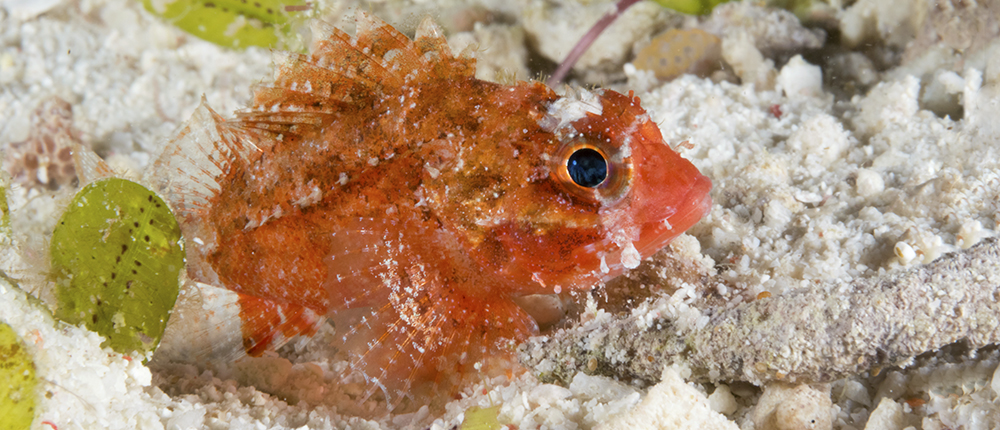Prickly Cuties
Though you’d never guess it by looking, some of the more poisonous creatures in the world lie in wait on the reefs around Wakatobi Resort. But don’t cancel your dive plans, because there’s no danger of divers or snorkelers being attacked. In fact, if you don’t know what to look for, you’d probably swim right past without noticing the various varieties of cunningly camouflaged scorpionfish that wait patiently for an unsuspecting morsel to swim within gulping range.
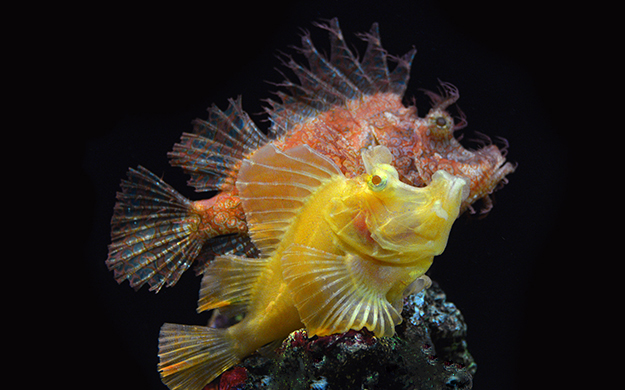
Here are two of the rarest varieties of scorpionfish; a yellow paddle flap rhinopias and a pink weedy rhinopias scorpionfish (both are sought after by many a macro photographer). Photo by Wakatobi Resort
Lumpy, spiny, and some would say downright ugly, these prickly cuties of the Scorpaenidae family would not seem like ideal candidates for glamour shots. And yet there are marine life photographers who go to great lengths to capture images of the rarer and most enigmatic members of this family. But even if portraits aren’t on your dive plan, scorpionfish are still fascinating subjects to study, and well worth devoting a few minutes of bottom time to a closer look.
More common than you think
There are several hundred species of scorpionfish inhabiting the world’s oceans, with the largest populations and greatest variety of species found in the waters of the Indo-Pacific, in marine environments like those surrounding Wakatobi Resort. These bottom dwellers don’t like to chase after a meal, or put up a fight. Instead, they have come up with some interesting tactics for both hunting and defense. The sharp spines projecting from a scorpionfish’s back and fins might seem like deterrent enough, but as an additional disincentive to attack, these rapier-like appendages are connected to poison sacs. Some species of scorpionfish will occasional use their toxic armament to stun a potential meal, but most often, they are deployed only for defense.
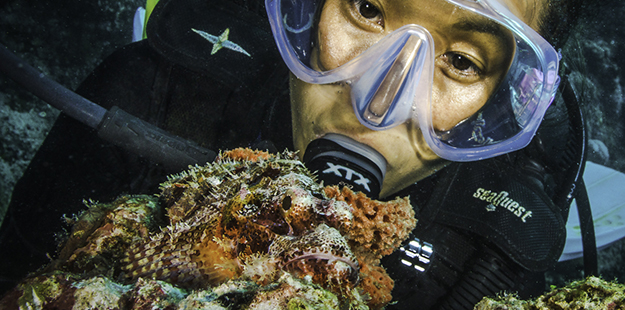
Tasseled scorpionfish make for interesting subjects; just remember to look but don’t touch. Photo by Wayne MacWilliams
On contact, the spines can deliver a dose of potent toxin that can stun or kill a potential predator, and cause a painful sting to a human foolish or careless enough to come in touch contact. Most stings to humans involve waders who step on a scorpionfish by accident.
The majority of scorpionfish aren’t strong swimmers, and some are actually more inclined to use their abbreviated pectoral fins to hop or crawl along the bottom. Instead of going after dinner, they blend into their surroundings and wait for something tasty to swim close. Scorpionfish tend to have heads that are large in proportion to the rest of their bodies, and these big heads hold equally large mouths. When an unsuspecting fish, crustacean or cephalopod happens along, the scorpionfish will open wide in a motion so swift it sucks the prey into be swallowed whole. In less than a tenth of a second, a scorpionfish can vacuum up a meal half its own size.
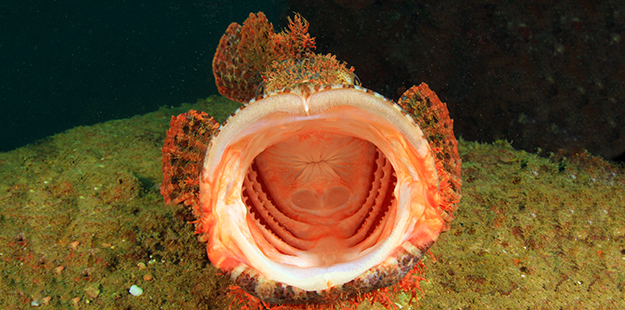
The scorpionfish will inhale their prey whole. In less than a tenth of a second, a scorpionfish can vacuum up a meal half its own size. Photo by Rich Carey
The scorpionfish’s hunting strategy is to simply sit and let an unsuspecting meal to come within range. While their cousins, the lionfish, make a point of standing with bright coloration and large plumage-like fins, the scorpionfish live inconspicuously on the sea floor. They lurk in crevices or burry themselves in sand and rubble by day, using a combination of shape, color and environmental camouflage to blend into the surroundings. Some sport dull mottled brown or yellow color patterns broken up by tassels, warts and specks. Others take on bright red or orange patterns that resemble an irregular patch of sponge. And thanks to all their sitting around, scorpionfish may actually grow a layer of algae, hydroids and marine parasites, make them look more like an debris-covered rock than a living thing. Once the growths get too thick, a scorpionfish will shed it’s outer layer of skin, and may make a color change at the same time.
You are unlikely to see scorpionfish added to any sort of endangered spaces list. Aside from a few sharks and rays that may take a bold and potentially painful nibble, they have few natural predators, and can live for as long as 15 years. Humans also leave them alone, as they have no commercial value for food or anything else. In addition, scorpionfish are prolific breeders. A female scorpionfish can release as many as 15,000 eggs into the water at one time, and will spawn many times each year. The fertilized eggs float to the surface where they are less likely to be found by predators. Eggs hatch in as little as two days, and the juveniles then remain near the surface until they are large enough to return to the protection of a reef or rock pile.
A female scorpionfish can release as many as 15,000 eggs into the water at one time, and will spawn many times each year. The fertilized eggs float to the surface where they are less likely to be found by predators. Eggs hatch in as little as two days, and the juveniles then remain near the surface until they are large enough to return to the protection of a reef or rock pile.

You’re most likely to encounter a tasseled scorpionfish on the reefs of Wakatobi. The giveaway is their beard-like tassels that break up the outlines of their body, and their beady eyes. Photo by Walt Stearns
Common finds and rarer encounters
If you start looking, it won’t take long to locate a scorpionfish on the reefs around Wakatobi Resort. The species you are most likely to encounter is the tasseled scorpionfish. With an average length of 14 in (25 cm), these are one of the larger varieties. Their coloration can vary greatly based on their surroundings, they sport rows of beard-like tassels that break up the outlines of their body. The giveaway is usually the beady and shining eyes, which don’t have the sort of frilly iris lappets that crocodilefish use to cloak their gaze. The tasseled is one of the more active scorpionfish—though that’s a relative term. If they feel threatened, they may pick up and move a short distance away, lifting from the bottom in a series of short swimming bursts that resemble hops. One of the more interesting spectacles you might witness on a night dive is an octopus stalking a tasseled scorpionfish. The octopus will envelop the scorpionfish in its tentacles, with seeming immunity to the toxic spines.
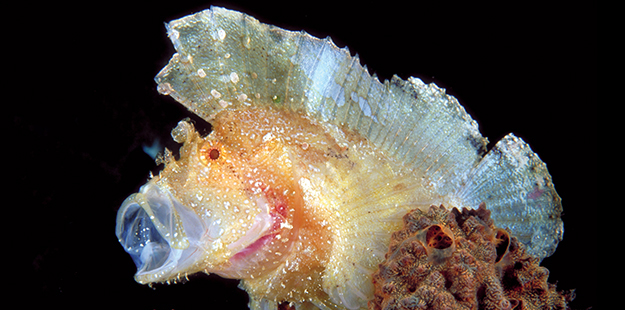
A good time to find leaf scorpionfish is late afternoon towards dusk, when they emerge from hiding to begin the hunt for a meal. The House Reef around the jetty is a great spot to do it. Photo by Rob Darmanin
Another common but not easily found species is the leaf scorpionfish, which may be encountered on the reef, or in the sand and grass beds closer to shore. Unlike many species of scorpionfish which cannot float, because they lack swim bladders, the leaf can can hold position off the bottom, and will often impersonate a dead leaf. This illusion is made possible by the fish’s extremely thin profile and elongated fins, and by the subtle sideways movements it makes to mimic a bit of drifting debris. The leaf scorpionfish’s color can vary from green, red, pink, brown, orange and yellowish to a ghostly white, and at just four inches (10cm) in length, this well-camouflaged species can be hard to locate. But as is often the case, once a diver does spot their first specimen, it becomes easier to spot the next one.
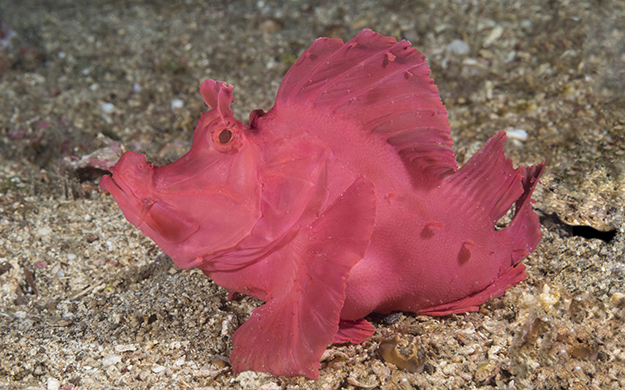
The rhinopias scorpionfish are named for their peculiar rhinocerous-shaped profile. But they’re still awfully cute. Photo by Walt Stearns
Many varieties of scorpionfish are burrowers, and this is also true of their close relative, the stonefish. When moving around the sea floor, take a close look at what may at first appear to be a partially burred and moss-covered rock. If you can see eyes, it’s probably a stonefish. And if you are lucky, you may even catch one in the act of borrowing in, using its fins to create a void that it settles into as if being sucked down into quicksand. Another burrower you are likely to encounter is the devil scorpionfish. This species has developed leaf-like spines that are not only be used for digging, but also to walk across the bottom. Other walkers include the rhinopias, which are named for the horn-like growths that adorn their faces. Rarer finds in this group are the paddle flap and the weedy scorpionfish, which are both favorites with photographers.
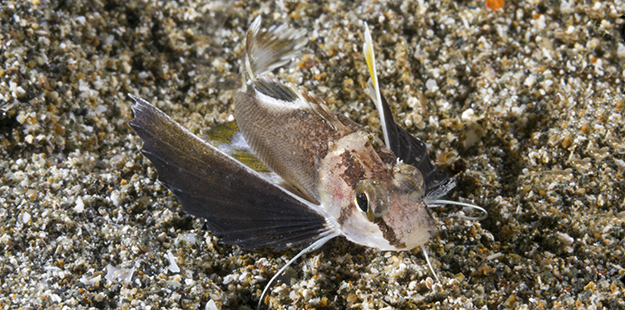
It’s easy to mistake a longfin waspfish for a sea robin; they can walk their way across the bottom in much the same fashion, so don’t be fooled. Photo by Walt Stearns
There are even more unusual ways that scorpionfish move about. The longfin waspfish might be mistaken for a sea robin or grunard, because it can either walk its way across the bottom or spread out a large pair of wing-like fins to flutter away. When it is forced to move, the ambon scorpionfish will flash it’s bright yellow pectoral fins in warning as it retreats with a series of hops. The cockatoo scorpionfish flops from side to side, allowing the distinctly-shaped fin atop its head to undulate like a leaf moved by wave energy. The longspine waspfish uses a similar strategy, allowing the tall dorsal fin that runs from head to tail to wave with an undulating motion that mimics floating debris that aquatic herbivores might mistake for a meal. This species is fairly common around Wakatobi, but you are more likely to see them on a night dive.
If you haven’t paid attention to scorpionfish in the past, take a few minutes to search one out on your next visit to Wakatobi Resort. Ask one of our keen-eyed dive guides for an assist in the hunt, and remember to look but not touch.
It’s time to plan your next great dive holiday. Contact us at office@wakatobi.com or complete a quick trip inquiry at wakatobi.com.


